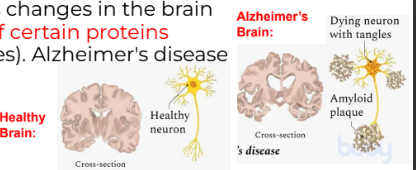AP Unit 4 Lesson 3 - Nerve Impulse Transmission
1/16
There's no tags or description
Looks like no tags are added yet.
Name | Mastery | Learn | Test | Matching | Spaced |
|---|
No study sessions yet.
17 Terms
How do neurons produce electrical signals?
Neurons generate electrical signals through brief, controlled changes in the permeability of their cell membranes to particular ions (NA+ / K+)
Changes in the concentration of NA+ and K+ ions inside and outside the nerve cell create electrical signals, called action potentials, which allow nerve impulses to travel along the cell.
Resting Potential of a Neuron
potential difference (voltage) across axomembrane when not conducting an impulse = ~ -65 mV
Cause of Negative Polarity
Negative polarity caused by:
1) Large negative anions (organic proteins) in axoplasm
2) Uneven distribution of ions:
Na+/K+ pump pushes 3 Na+ out for every 2 K+ brought in when returning axon to resting potential
Resting Potential of a Neuron pt. 2
At rest:
More Na+ on the outside of neuron
More K+ on the inside of neuron
Overall - Negative change on the inside is due to large negative proteins
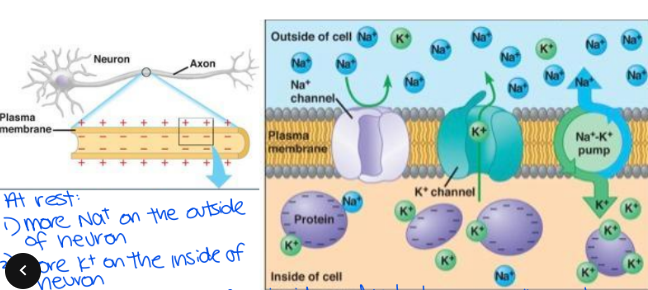
What is Action Potential - The Nerve Impulse
1) an electrochemical change that moves in one direction along the length of the nerve fiber
2) caused by nerve stimulation (sensory stimuli)
Action Potential Steps: 1) Depolarization
1a) Axomembrane becomes permeable to Na+ ions:
Na+ ions moves from outside to inside of axon (via facilitated transport)
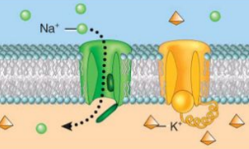
Action Potential Steps: 1) Depolarization pt. 2
1b) More Na+ channels open and axomembrane becomes even more polarized
the membrane potential changes: -65 mV to +40 mV
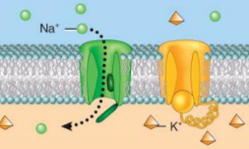
Action Potential Steps: 2) Repolarization
2a) Axomembrane becomes permeable to K+ ions:
voltage gated Na+ channels close
voltage gated protein channels specific to K+ open
K+ ions move from inside axon to outside (facilitated transport)
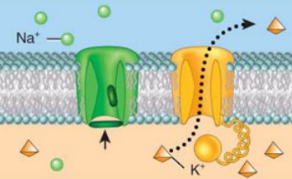
Action Potential Steps: 2) Repolarization pt. 2
2b) Axomembrane becomes repolarized:
the inside of axon returns to resting potential, membrane potential changes from +40 mV to -65 mV
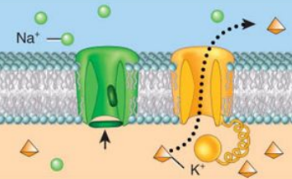
Action Potential Steps: 3) Recovery (Refractory Period)
3) Refractory Period: small amount of time when a new impulse cannot be sent
between nerve impulse transmissions, the protein pump moves Na+ and K+ ions across the membrane to restore their original concentration levels

Action Potential Steps: 3) Recovery (Refractory Period) pt. 2
both Na+ and K+ are moved against the [ ] gradient
Action Potential Graph
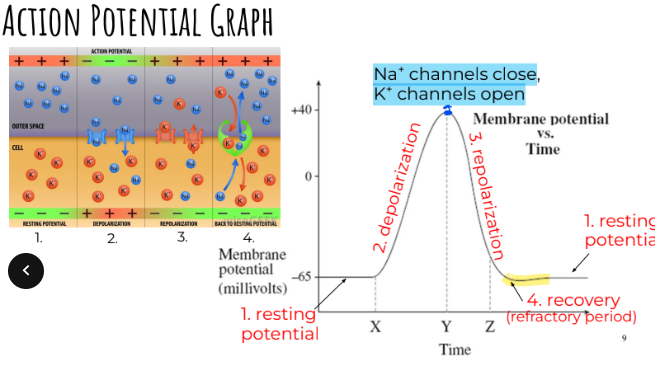
Nerve Impulse Transmission Speed
Myelin Sheath: lipid covering that allows for rapid speed of nerve impulse transmission (via insulation)
Nerve Impulse Transmission Speed pt. 2
Transmission in 2 ways:
1) Myelinated Fibers (Saltatory Conduction): nerve impulse “jumps” from node of Ranvier to next node
Speed: ~ 200 m/s
2) Non-myelinated fibers: impulse must depolarize & repolarize at each point along the fiber
Speed: ~ 0.5 m/s
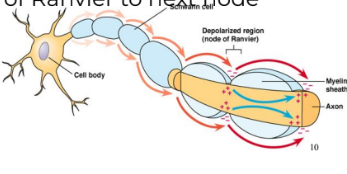
Nervous System Diseases
Multiple Sclerosis:
The immune system attacks the myelin sheath and causes communication problems between your brain and the rest of your body
Eventually, the disease can cause permanent damage or deterioration of the nerve fibers
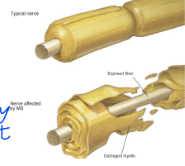
Nervous System Diseases pt. 2
2) Alzheimer’s:
causes changes in the brain that leads to deposits of certain proteins
Alzheimer’s disease causes the brain to shrink and eventually causes brain cells to die
